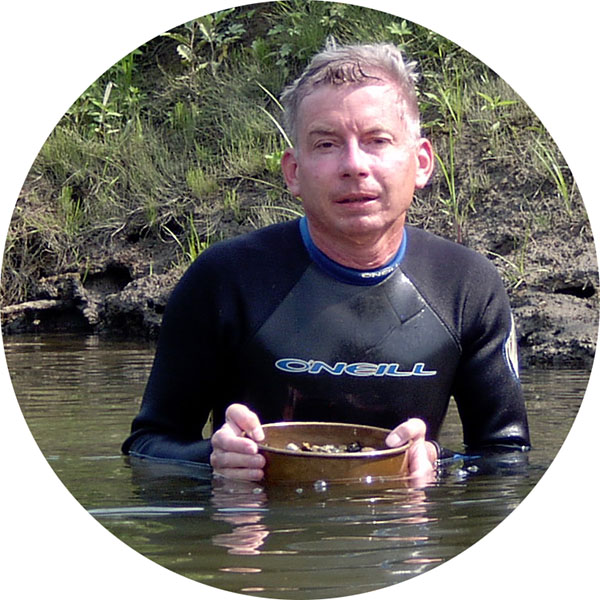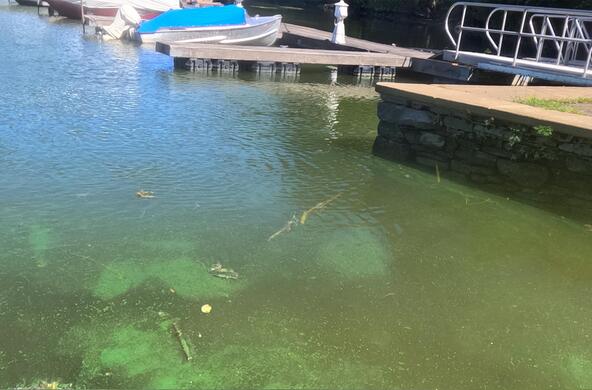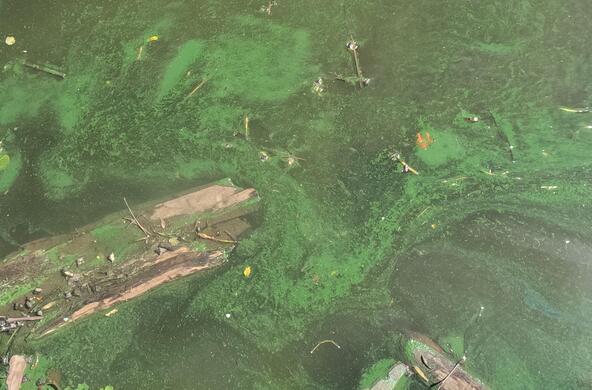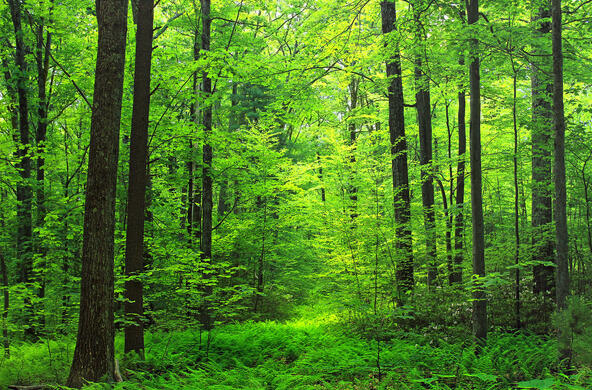Ecosystem changed much in 400 years
“Would Henry Hudson even recognize the Hudson River if he sailed up it today?” My friend Lori asked me this question the other day as we were talking about the upcoming 400th anniversary of the European discovery of the river, and all the ecological changes that have taken place since then.
Even though the river has been thoroughly transformed by human action, I think Hudson and his crew would know the river as they sailed through the New York harbor and past Manhattan. With a sailor’s fine sense of currents, soundings and the shape of the shore, they would hardly fail to recognize the fine deep-water harbor, the strong, swirling currents of the East River and Spuyten Duyvil, and the imposing Palisades on the New Jersey shore. Further upriver, they would remember the broad waters of the Tappan Zee and Haverstraw Bay, and the imposing Hudson Highlands.

Entrance to the Highlands of the Hudson, Hippolyte-Louis Garnieer. Albany Institute of Art
Of course, they would notice how much the shoreline had been improved; the little wetlands and beaches had been replaced with tidy seawalls and useful piers. Surely they would marvel at Manhattan and wonder what great race had built this glittering city, but they would know the river. Apart from the obvious signs of an advanced civilization (soaring bridges, strange iron tracks along both banks), the straight, deep channel of the river and its wooded banks would be familiar, as least as far as the City of Hudson.
Problems began north of today’s city
Hudson is where the explorer’s troubles really began in 1609. What had been a navigator’s dream south of Hudson - a beautiful deep channel - turned into a bewildering nightmare of islands and side channels north of the city. The crew must have spent all their time trying to find the water and sounding for shoals, their dream of a Northwest Passage fading fast.
Hudson and his crew would be well pleased with what they would find in the river north of the city of Hudson today - the maze of islands and shoals replaced by a clear, deep channel as far as Albany, courtesy of two centuries of dredging, filling, and channel-training. And that wretched mud bank at Castleton - the nemesis that grounded his ship in 1609! - gone without a trace.
Neither Hudson nor his crew had much interest in ecology, so it’s not likely they would have noticed most of the profound ecological changes that have occurred in the river since 1609. But what if there had been an ecologist on board in 1609, say Henry’s cousin Peter (“Doc”) Hudson, a lad who had grown up as a seafarer like Henry, but who had always been more interested in the animals that grew on the hull of the ship than in the ship itself (how odd), and who thought of trees as something more than potential masts.
He would notice much that escaped Henry’s eye. The forests, for instance. Henry would have said that the land outside the cities was still largely covered with forests and left it at that, but Peter would have seen at once that the forests of 2009 were quite different from what they had seen in 1609. These new forests were young, for one thing, with few of the giant pines, oaks, or chestnuts Peter had remembered.
Although Peter would have known he was looking at a different forest, it seems unlikely he would have the insight that he was looking at a landscape that had been almost entirely cleared and domesticated in the 18th and 19th centuries, then gradually abandoned back to the forest after the Civil War.
And where were the chestnut trees, so common on their earlier voyage, and so valuable to humans and wildlife alike? Had loggers come through and cut down all of the chestnuts? (And the elms - weren’t there more elms along Hudson’s river?) What was troubling the hemlocks that lined the glens of the Highlands and Catskills, now only gray skeletons? Peter would have no way of knowing that it was not logging, but diseases carelessly brought into North America, that led to the demise of the chestnuts, the elms and now the hemlocks.
400 years later, Hudson less diverse, but easier to navigate
This is the second of four pieces in which we’re charting the ecological changes that have occurred in the Hudson River since it was “discovered” by Henry Hudson in 1609.
What changes would Hudson (and his imaginary cousin, Peter “Doc” Hudson, the ecologist) notice if they sailed up the river in 2009?
The transformation of the upper part of the Hudson, from a tangle of islands and useless side channels in 1609, into a decent channel today that his ship could use without sounding for shoals every three minutes, would have put Henry into a rare good humor.
Peter would have been confused and disappointed, though. Where were the stands of wild rice and tall grasses that had rippled so beguilingly in the breeze? Where were the flocks of speckled teal and comical peeps that used the shallows and mudflats of the Hudson as a welcome stopover in their long migration south? Where were the blind channels that opened so promisingly to entice ships, then narrowed to an impassable slot, which Cousin Henry had cursed with such vigor and eloquence? And, most of all, where were the innumerable islands he remembered from the earlier voyage, lined with tall cottonwoods and so endlessly fascinating and individual?
 Although still found in the Hudson River, shad were far more abundant in 1609. (Illustration by Ján C. Porinchak)
Although still found in the Hudson River, shad were far more abundant in 1609. (Illustration by Ján C. Porinchak)
Peter had to agree with Huck Finn, who although himself the creation of a riverboat pilot, thought islands gave rivers much of their charm and mystery. With no disrespect to his cousin Henry, who was surely a great explorer, Peter would have named this river “The River of Islands.”
From 68 to 24 islands
If Peter had been a really careful observer, he would have recorded that the new, improved version of the Hudson River in 2009 lacked 44 of the 68 islands he had seen in 1609 (each of which he had given fanciful names: The Sleeping Cat, Shad Island, Circe’s Isle and so on) and was missing 3,800 acres of rich shallow-water habitats (see illustration).
And it was not only charm these islands, shallows and side-channels gave the Hudson. The upper river in 1609 must have been alive with birds, fish and all kinds of plants and animals that found their food and homes in the complex array of habitats. Peter would have filled his sketchbooks with drawings of plants and shells and waterfowl and quick little fishes that abounded in the vegetated shallows. I’m sure Peter would have tried to capture the amazing colors of the drake wood duck, the ephemeral iridescence of young shad and the ferocious appearance of the huge snapping turtles he found in the riverside marshes.
Some of the species Peter would have seen among the islands are now scarce in the Hudson, or have vanished altogether from the river as their preferred habitats disappeared. Even species still common in the river, such as shad and river herring, must have been more abundant in 1609 as they benefited from the rich nursery and feeding grounds the vanished river-shallows offered. Of all the parts of the Hudson and its surrounding watershed, this is the place I would most like to see in its original state.
I don’t mean to suggest these habitats are gone entirely from the Hudson. There are still 24 islands in the river, enticing anglers, campers and modern-day Huck Finns, and some marshes and side-channels still exist, especially between Kingston and Castleton, Rensselaer County.
We are fortunate the Hudson still contains 4,450 acres of submerged plant beds, chiefly water-celery, a valuable species for invertebrates, fish and waterfowl. And these remaining patches of shallow-water habitat still fill up in season with migrating birds and baby fishes, and are wonderful places for us to visit. But we will never see the tangle of islands, side-channels and marshes of the upper Hudson that Henry saw (and undoubtedly cursed) in 1609.

Water celery, a native submerged aquatic plant, provides a valuable habitat for fish and other aquatic animals. (Photo by Eugenia Barnaba)
River’s inhabitants different today
Human changes to Hudson caused shift in species
This is the third of four pieces in which we’re charting the ecological changes that have occurred in the Hudson River since Henry Hudson first saw it 400 years ago. Today, we’ll consider the species that have appeared or disappeared from the Hudson as a result of human activities. What changes would Henry (and his imaginary cousin Peter “Doc” Hudson, the ecologist) see if they sailed up the Hudson in 2009?
Doc was a careful observer of biology, and spent much of his time in 1609 examining and sketching the new plants and animals that he found in the river. What a shock it was in 2009 to find what was clearly the same river occupied by different plants and animals! Several times he consulted his old notes in bewilderment, thinking his memory had failed him.
For instance, where were the oysters? One of his indelible memories of the harbor, apart from its beauty and Cousin Henry’s delight at its depth and breadth, was the abundance of oysters it held. Miles and miles of oysters, plump and succulent. This time it had taken three days of dredging before they saw their first oyster, and that one was puny. Instead, the dredge kept coming up full of small, wedge-shaped clams (wedge rangia, an invader that first appeared in the 1980s) that he had never seen before, tasty enough it was true, but hardly a substitute for the oysters that had sustained the crew in their earlier voyage.
Sturgeon, shad decreased
He also had fond memories of the Hudson’s sturgeon. Although they had captured only one or two, they often saw these enormous fish splashing and jumping. This voyage they had trawled up just one sturgeon (one of the small kind), and hadn’t seen any of them leaping. And had he misremembered the abundance of shad? They were seeing shad to be sure, but in small schools, not in the endless shoals that he recalled.
There were subtle and disturbing changes as well, ones he wouldn’t have been sure of if he hadn’t had his old journals at hand. For instance, he remembered trawling up lots of catfish off of the muddy bottoms, but they were small and square-tailed (the native white catfish), not the big sleek fish with forked tails (the introduced channel catfish) that filled the nets now. How could the catfish have changed so much?
Then there were the species he hadn’t recorded at all in 1609, too numerous and distinctive (Peter kept assuring himself) to have been overlooked in that earlier voyage. The remarkable, bright-green beds of some tropical-looking plant everywhere in the shallows (water-chestnuts). Going in to get a close look, Peter had gotten the jolly boat completely entangled in the strange plants, to the delight of the catcalling crew.
Also new were the tiny zebra-striped mussels that covered the rocks as well as the plump (and delicious) big green perch (black bass, imported from the Midwest) that lurked among rock piles and weed beds. Where had these new plants and animals come from? The crew always called him a dreamer, but it was hard to believe he had been so inattentive in 1609 that he had somehow missed these dozens of species. Or had he … ?
Poor Peter had no way of knowing the changes that so puzzled him were the product of four centuries of overharvesting and species introductions. Overharvesting has nearly eliminated the big sturgeon and fat oysters from the river, and brought stocks of shad and other species to a tiny percentage of their former abundance.
At the same time, canals, deliberate stocking, careless release of pets and plants and hitchhiking species riding in the hulls and holds of boats have brought more than 100 foreign species into our local waters. Some of these species are desirable (the tasty largemouth and smallmouth bass Peter noticed), but many (such as the entangling water-chestnut and the zebra mussel) cause ecological and economic problems. Taken together, these changes have made the Hudson a very different ecosystem than the one Henry saw in 1609.

The deepening of the river channel, the construction of dikes and the filling of shallows, improved the navigability of the Hudson, but adversely affected the river's ecosystem. Sensitive habitats, such as tidal marshes, have been compromised and many are essentially closed off from the main river. It is estimated that over 50% of the shoreline of the Hudson River has been modified.
River harbors signs of serious harm
Traces of dumping apparent; diseased fish hint at impact
This is the last of four pieces in which we’re charting the ecological changes that have occurred in the Hudson River since Henry Hudson sailed up the river in 1609. What changes would Henry (and his imaginary cousin Peter “Doc” Hudson, the ecologist) notice if they sailed up the river in 2009?
Today we will consider some important changes that have occurred that even careful observers might miss.
Of all the human effects on the Hudson River since 1609, probably the best known is toxic pollution. After all, because of PCB contamination, the Hudson River is the country’s largest Superfund site, and has been the subject of protracted legal and public relations battles between General Electric and environmental organizations and the Environmental Protection Agency to decide whether and how these toxins should be removed from the river. The Hudson has also been badly polluted by sewage, toxic metals, paper mill wastes, pesticides and other residues of our industrialized society. So in this series of essays about ecological changes in the Hudson over the past 400 years, why have I waited until the end to mention toxic pollution?
These essays are based on the reactions of Henry Hudson and his imaginary cousin Peter (an ecologist) to the changes they saw upon their revisit to the Hudson after 400 years. Without sophisticated instruments such as gas chromatographs and modern spectrometers, Peter and Henry would have no way of seeing the full extent of the toxic contamination of the river, although Peter would surely have noticed unmistakable signs we’ve been using the Hudson as our wastebasket and our toilet.
The first signs would come as soon as the explorers arrived in the harbor. Bushels and bushels of plastic and other trash are floating on the water and piled up in windrows along the waterline. Peter would have been baffled by many of the objects he found. What could these be used for? But there would be no doubt in his mind they had been made - and discarded - by humans.
Smells different
Peter would have noticed the smell, too. Wherever he dredged up the river mud looking for shellfish, he would have wrinkled his nose against the oily smell, a smell that would stick tenaciously to his hands or anything else touched by the mud. He also would become familiar with the thin rainbow sheen of oil, which he would perhaps admire without understanding its origin.
He would be more upset by what he found when he cleaned the tomcod for their meals. He remembered these small, delicious fish from their earlier voyage, but he certainly didn’t remember the grotesque growths on their livers. More than half of the adult tomcod in today’s Hudson suffer from liver cancer, a disturbing product of industrial contamination.
The other signs of toxic contamination of the Hudson, so pervasive and obvious to a modern environmental scientist, would probably be too subtle for our 17th-century visitor to notice. However subtle, the contamination of the Hudson has made a lasting impression on Henry’s river and devalued its utility to us as a source of food and recreation.
Changes abound
There hasn’t been the space in this little series of essays to describe all of the important ecological changes that have occurred between 1609 and 2009. I haven’t even mentioned the effect of the railroads in creating wetlands such as Tivoli North Bay, or the innumerable dams that block fish migrations everywhere in the Hudson’s tributaries, or the countless changes to the river arising from wholesale transformation of its watershed, and so on.
It isn’t necessary to go through the entire catalog of ecological changes to answer the question that inspired these essays: “Would Henry Hudson even recognize the Hudson River if he sailed up it today?”
Yes, Henry Hudson probably would recognize the river that bears his name. However, we’ve changed the river in so many ways it really isn’t the same river anymore. In this sense, Henry would recognize his river, but he would be wrong.
Here’s a question to ponder for the next 400 years: If we were to sail up the Hudson in 2409, would we recognize it? Or will our careless stewardship of the river and its planet bring us yet another Hudson River, more degraded than the last?







